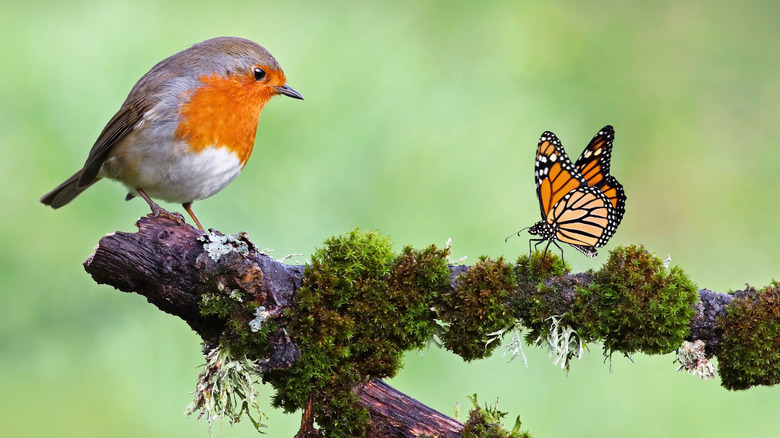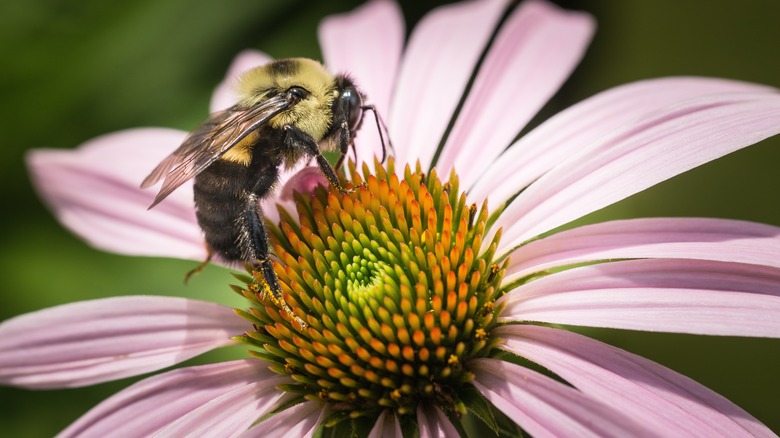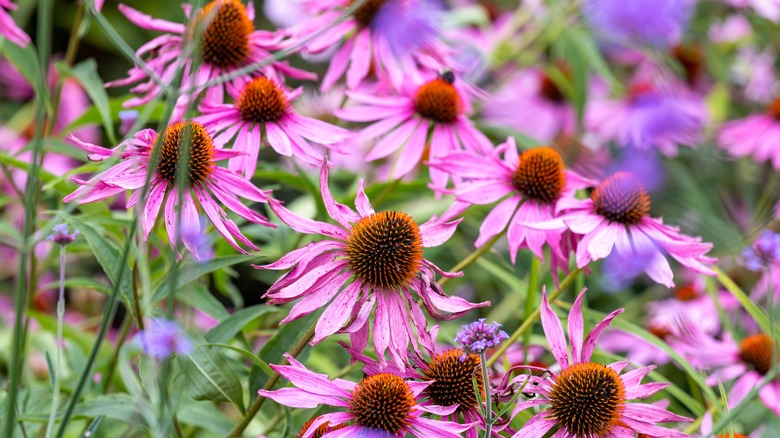The Stunning Plant That'll Have Birds And Butterflies Flocking To Your Yard
More and more gardeners are interested in planting flowers that attract pollinators to their gardens. Pollinators include bees, butterflies, moths, hummingbirds, and a range of other insects and wildlife. They may consume nectar or pollen for food, and/or may transfer it from one plant to another, aiding in pollination. Some plants produce both nectar and seeds, making them a source of food for both pollinators and songbirds. One of the best perennial flowers that produces nectar for pollinators and seeds for birds is the coneflower (echinacea).
The native coneflower, Echinacea purpurea, is also known as purple coneflower. Its pink-purple flower petals start out very bright and eventually fade to pastel colors. There is also a white variety, with white petals tinged with green. The deep orange cone-shaped center, which gives the flower its common name, produces abundant nectar for bees, butterflies, and other insects in the summer. The flower's bright colors attract hummingbirds, fast-flying pollinators who also sip the flower's nectar.
The center cone of the echinacea is also covered with seeds. Once the flower matures and these seeds begin to dry out, they attract birds, who snack on them in the fall. Squirrels, chipmunks, and other seed-loving rodents may also occasionally eat these seeds, but only if the birds leave any behind.
The benefits of coneflowers in the garden
There are a number of reasons why the purple coneflower is a desirable plant to have in your pollinator garden. The flowers are large, providing ample space for pollinators to land on them. The color is also in a range easily seen by bees (the insect has difficulty seeing red flowers). They also produce abundant nectar and pollen, providing food for a variety of insects. The flowers bloom for a long period of time (often up to eight weeks or more) and so provide nectar from midsummer to early autumn.
Purple coneflower produces large clumps of flowers and increases fairly rapidly, while also reseeding in the garden without being terribly invasive. Birds who transport the seeds will also help the plants reseed. These plants are very drought-tolerant and easy to care for, requiring no special care or fertilizing. They grow up to 3 feet tall and are good perennials for cottage gardens or at the back of the border behind shorter flowers.
Leaving the seedheads of your coneflowers intact after the blooms have faded has two benefits; first, the seeds provide food for birds into fall and winter, especially finches who seem to love them. Second, the large seedheads provide winter interest in the garden, as well as a bit of shelter for hatching insects in early spring.
Which coneflowers to plant
When selecting coneflowers for your garden, you will have many choices to consider. There are many beautiful new hybrids that come in a wide range of colors and shapes, some with pom-pom centers or double rows of petals. They have dramatic names describing their vivid colors, like Tiki Torch and Cantaloupe, and produce long-lasting blooms. While these hybrids look great in the garden, many are sterile and don't produce pollen or nectar. The pom-pom varieties also don't produce seeds. So these kinds of echinacea are not the best ones for attracting pollinators to the garden. If you want to plant hybrid coneflowers, be sure to plant some native ones, too.
The pollinator-friendly native coneflowers are Echinacea purpurea (purple coneflower), Echinacea pallida (pale purple coneflower, which has long, thin daisy-like petals that droop downward from the flower centers), and Echinacea augustifolia (narrow-leaved purple coneflower, which has similar colors to the purple coneflower but with short, compact flower petals). These flowers will reseed themselves readily and produce abundant nectar and seeds for pollinators, birds, and wildlife.
It's also important to obtain echinacea plants that have not been treated with any pesticides, particularly neonicotinoids, which have been associated with colony collapse disorder, a condition leading to the loss of honeybee populations. Keeping your garden environment free of chemical pesticides and herbicides is crucial for maintaining an environment that will attract and support pollinators.


